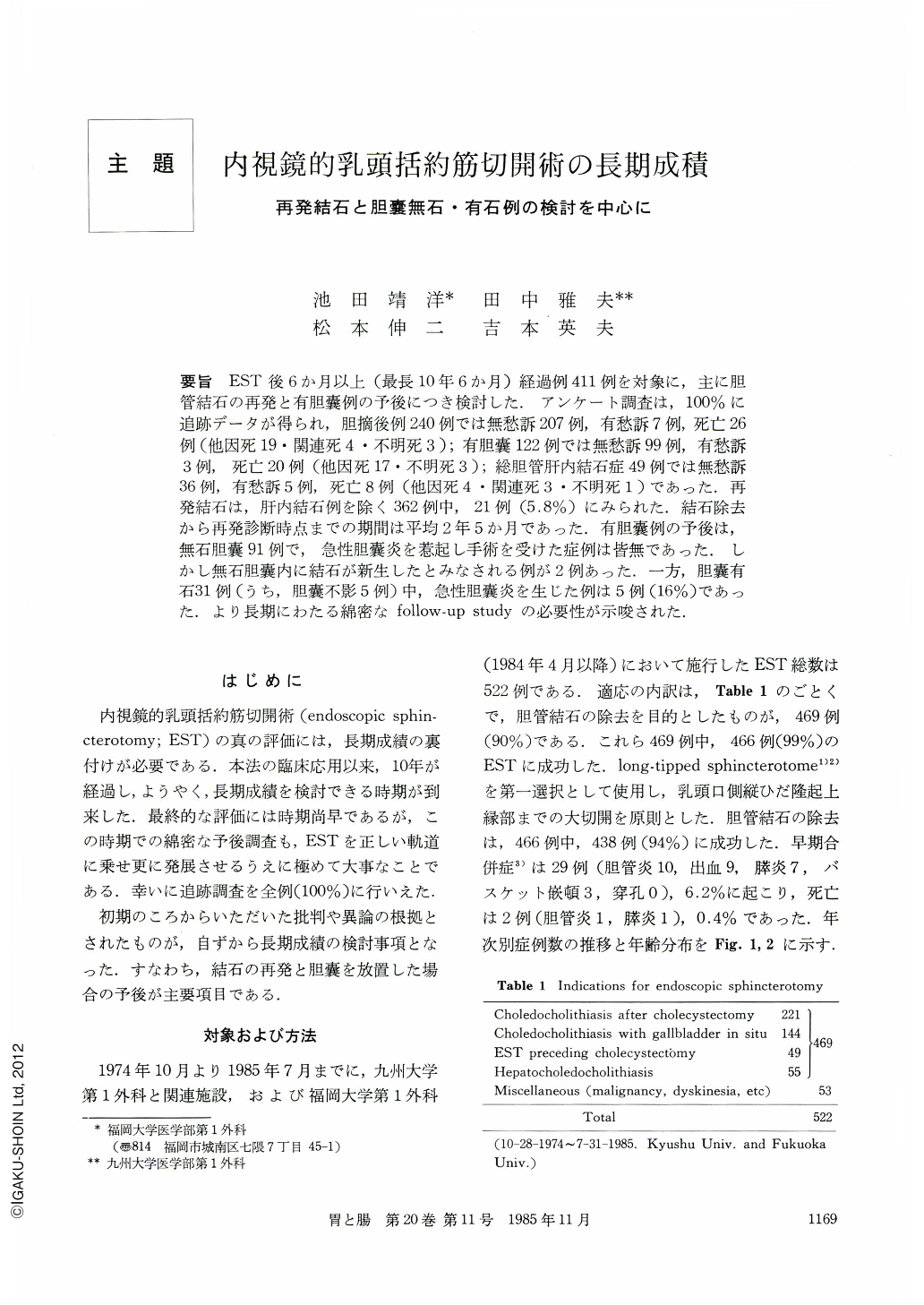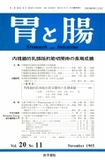Japanese
English
- 有料閲覧
- Abstract 文献概要
- 1ページ目 Look Inside
要旨 EST後6か月以上(最長10年6か月)経過例411例を対象に,主に胆管結石の再発と有胆囊例の予後につき検討した.アンケート調査は,100%に追跡データが得られ,胆摘後例240例では無愁訴207例,有愁訴7例,死亡26例(他因死19・関連死4・不明死3);有胆囊122例では無愁訴99例,有愁訴3例,死亡20例(他因死17・不明死3);総胆管肝内結石症49例では無愁訴36例,有愁訴5例,死亡8例(他因死4・関連死3・不明死1)であった.再発結石は,肝内結石例を除く362例中,21例(5.8%)にみられた.結石除去から再発診断時点までの期間は平均2年5か月であった.有胆囊例の予後は,無石胆囊91例で,急性胆囊炎を惹起し手術を受けた症例は皆無であった.しかし無石胆囊内に結石が新生したとみなされる例が2例あった.一方,胆囊有石31例(うち,胆囊不影5例)中,急性胆囊炎を生じた例は5例(16%)であった.より長期にわたる綿密なfollow-up studyの必要性が示唆された.
For a 10-yr and 10-mo period from October 1974 through July 1985, 522 patients had endoscopic sphincterotomy (EST) performed (Table 1). The success rate was 99% for EST and 96% for removal of common bile duct stones. Immediate complications occurred in 29 patients (cholangitis 10, bleeding 9, pancreatitis 7, basket impaction 3, perforation 0), two of whom died of the complication of cholangitis or pancreatitis,yielding the mortality rate of 0.4%. 411 patients followed up for over 6 mo after EST were analyzed. 240 patients had their gallbladder removed before (198 patients) or after (42 patients) EST, while 122 had the gallbladder in place, including 91 without, 25 with stones in the gallbladder and 6 with nonvisualized gallbladder. Postal survey or phone interview was conducted four times (1979, 1983, 1984, 1985) and endoscopic retrograde cholangiography (ERC) was performed in selected cases.
Follow-up informations were obtained by all means and available in all cases at the 1985 survey (Table 3). 97% of 214 alive patients without gallbladder, 97% of 102 alive patients with gallbladder and 88% of 41 alive patients with hepatocholedocholithiasis had no complaints, whereas others had some possibly biliary symptoms. 7 patients died of cholangitis or liver abscess during the follow-up period. Common bile duct stones recurred in 21 patients (5.8%). The high recurrence rate as compared with other series may be attributable to our enthusiastic follow-up investigations including ERC. Recurrent stones were found in 2 asymptomatic patients at follow-up ERC, indicating that results of a postal survey do not represent a true rate of recurrence. The time interval between clearance of the common bile duct and the recurrence ranged from 4 mo to 7 yrs (mean 2 yrs 5 mo) (Fig. 4). Acute cholecystitis occurred only in patients with gallbladder stones (3 patients) or nonvisualized gallbladder (2) at 9 mo to 2 yrs 5 mo (mean 1 yr 9 mo) after EST (Fig. 8), suggesting that cholecystectomy should be advocated in non-high risk patients with gallbladder stones after EST. The patients without gallbladder stones had uneventful courses except for 2 patients, who had gallstones newly formed 7 mo (Fig. 8) or 3 yrs 8 mo after EST. This fact indicates that even patients with acalculous gallbladder should carefully be checked with regard to possible development of new stones in the gallbladder.

Copyright © 1985, Igaku-Shoin Ltd. All rights reserved.


